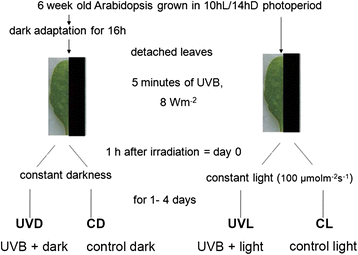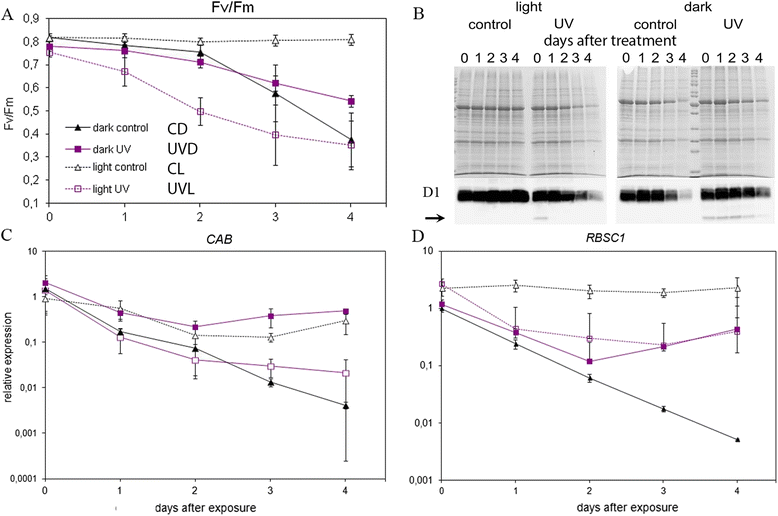The effect of UV-B on Arabidopsis leaves depends on light conditions after treatment
- PMID: 26608826
- PMCID: PMC4660668
- DOI: 10.1186/s12870-015-0667-2
The effect of UV-B on Arabidopsis leaves depends on light conditions after treatment
Abstract
Background: Ultraviolet B (UV-B) irradiation can influence many cellular processes. Irradiation with high UV-B doses causes chlorophyll degradation, a decrease in the expression of genes associated with photosynthesis and its subsequent inhibition. On the other hand, sublethal doses of UV-B are used in post-harvest technology to prevent yellowing in storage. To address this inconsistency the effect of short, high-dose UV-B irradiation on detached Arabidopsis thaliana leaves was examined.
Results: Two different experimental models were used. After short treatment with a high dose of UV-B the Arabidopsis leaves were either put into darkness or exposed to constant light for up to 4 days. UV-B inhibited dark-induced chlorophyll degradation in Arabidopsis leaves in a dose-dependent manner. The expression of photosynthesis-related genes, chlorophyll content and photosynthetic efficiency were higher in UV-B -treated leaves left in darkness. UV-B treatment followed by constant light caused leaf yellowing and induced the expression of senescence-related genes. Irrespective of light treatment a high UV-B dose led to clearly visible cell death 3 days after irradiation.
Conclusions: High doses of UV-B have opposing effects on leaves depending on their light status after UV treatment. In darkened leaves short UV-B treatment delays the appearance of senescence symptoms. When followed by light treatment, the same doses of UV-B result in chlorophyll degradation. This restricts the potential usability of UV treatment in postharvest technology to crops which are stored in darkness.
Figures







References
-
- Teramura AH. Effects of ultraviolet‐B radiation on the growth and yield of crop plants. Physiol Plant. 1983;58:415–27. doi: 10.1111/j.1399-3054.1983.tb04203.x. - DOI
Publication types
MeSH terms
Substances
LinkOut - more resources
Full Text Sources
Other Literature Sources

